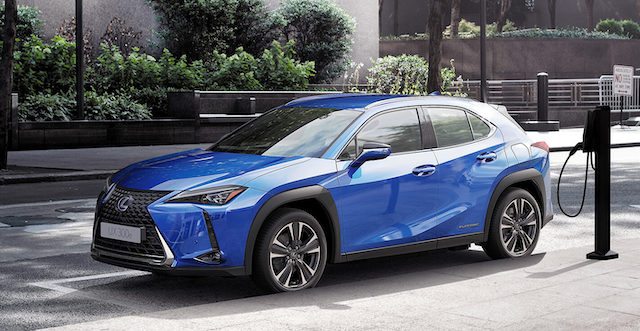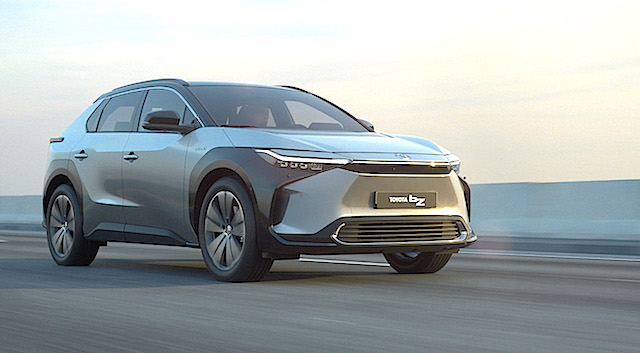
- In the past couple of years the number of battery-electric (BEV) and plug-in hybrid electric vehicles (PHEV) available worldwide has increased upwards of 40 per cent, to around 370. And more are on the way, many from start-ups that have had little to do with the automotive industry until now …
Automotive engineers the world over agree: the use of liquids is the best way to cool lithium-ion packs in battery-electric vehicles (BEVs).
So why is premium Japanese brand Lexus using air cooling in its first BEV when its mainstream parent Toyota is using liquid cooling in its first? We’re talking here of the Lexus UX 300e and the Toyota bZ4X.
The Lexus (above) is on sale in New Zealand now; the Toyota is expected later this year. There are two versions of the front-drive UX 300e: Standard and Limited. There will also be two versions of the bZ4X, one (FWD) front drive, one (AWD) all-wheel drive.
Says Lexus NZ product manager Logan Potter: “Air cooling is cheaper, lighter and less complex than liquid cooling. Liquid cooling for the UX (300e) wasn’t deemed necessary, due to the battery size and capacity.
“If UX was to have liquid cooling it would have been heavier and potentially more expensive. It may have also compromised its handling, which was a big consideration for the 300e. The ‘Lexus driving signature’ was very important – that is, the Lexus first, EV second philosophy.”
There are three main methods of cooling:
- Phase change
- Fins
- Air
- Liquid
Lithium-ion packs are built with a liquid electrolyte to manage the flow of energy between the negatively charged cathode and positive anode. In BEVs, discharging the battery generates heat. The more rapidly a battery discharges, the more heat it generates. The liquid electrolyte needs constant cooling.
- Phase change material acts as a heat sink, altering its state from a solid to a liquid to absorb heat from the battery. It can absorb large amounts of heat but it can’t transfer it away. Therefore it does not reduce overall temperature as well as the other systems.
- Fins transfer heat from the battery pack to the fin through conduction, and from the fin to the air through convection. But the extra weight fins add to the pack outweighs cooling benefits.
- Air uses convection to transfer heat away from the battery pack. It is simple and easy, but not very efficient, particularly in hot climates.
- Liquid is the most effective method. It delivers the best performance for keeping a battery pack in the correct temperature range of about 20-40deg C. It can also keep the temperature difference within the battery pack to a minimum (no more than 0.5deg C, say engineers).
The UX 300e uses a 54kWh battery that feeds a 150kW/300Nm electric motor/generator driving the front wheels. Range is good for 300km and up, says Lexus.
Toyota’s bZ4X (above) has a 71kWh pack. A 150kW/265Nm motor/generator drives the front wheels. The AWD version gets two 80kW motors, one up front and one in the rear, for a combined 160kW/336Nm. God willing and the creek don’t rise, the bZ4X might squeeze out 450km.
The kWh rating indicates how much energy the battery has on hand to power the vehicle’s electric motor. Without getting too deep into the explanatory weeds, the more energy a battery has the further the vehicle can go before it needs recharging.
Potter’s reference to the weight of a liquid-cooling system being a potential handicap to Lexus dynamics is thought provoking. So let’s weigh the three vehicles, according to Lexus and Toyota statistics. The Toyota is bigger than the Lexus: 195mm longer, 20mm wider, 105mm taller, and has a 210mm longer wheelbase.
- Kerb weight: the UX 300e is 1850kg. The FWD bZ4X is 1920kg, the AWD bZ4X is 2005kg. The UX 300e is lighter by between 70kg and 155kg than the bZ4X variants.
- Gross weight: That’s the kerb weight plus the payload, say three or four adults and bags and stuff. The 300e payload is 395kg, gross weight 2245kg. The FWD bZ4X payload is 275kg, gross weight 2195kg. The AWD bZ4X payload is 270kg, gross weight 2275kg. The extra 120-125kg payload of the smaller 300e is roughly the weight of an All Black prop.
Therefore the all-up weight of the 300e is 50kg heavier than the FWD bZ4X and 30kg lighter than the AWD bZ4X. It could be argued that Lexus’ decision to use air cooling had more to do with keeping costs down than weight.
There might be two UX 300e models but only the $79,900 Limited is aimed at the private buyer. The Standard comes with fewer goodies and is reserved for corporate and government fleets only.
Both however qualify for the government’s $8625 clean car discount, which allows Lexus even more wiggle room with fleet contracts. The Standard will go back to Lexus at the end of the lease. Expect to see it among Lexus’ approved used cars.
- The UX 300e is likely to be the last air-cooled lithium-ion BEV from Lexus. Its parent Toyota has pledged to get its first car using more efficient solid-state batteries on the road by 2025. It is expected to be a hybrid rather than a BEV. Also, Lexus has said it is building a new sports car, a BEV with the bloodlines of the V10-powered LFA. It may also use solid-state batteries to provide a claimed 700km range and a 0-100km/h time of under 2.5 seconds.

